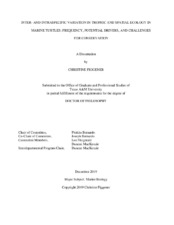| dc.description.abstract | My dissertation explored the interspecific variation in trophic ecology in marine turtles in general, and the variation in resource use and migratory routes in one population of olive ridley turtles (Lepidochelys olivacea) in the Eastern Tropical Pacific (ETP) in specific. I used a meta-analytical approach, stable isotope analysis, and satellite telemetry to characterise variation in resource use among different species and across different hierarchical level, variation in resource use among individuals of one population of L. olivacea nesting in Costa Rica, and analysed the migratory routes of the same population to identify potential drivers of observed variation, as well as its implications for conservation management. The value of marine turtles as a model system for understanding broader ecological and evolutionary questions is underappreciated, and my findings have broader implications for the study of radiations, as well as for conservation. My dissertation aimed to unify existing data on marine turtles and reveal variation among and within species. It further aimed to show how using marine turtles as a model system and the already existing substantial volume of data is providing a unique opportunity to ask questions about ecology and evolution in a large, long-lived marine vertebrate. My dissertation also aimed to encourage a shift in how questions about marine turtles are asked by placing data, although mainly collected for conservation purposes, into the context of their broader ecology and evolution.
My results show that a more intricate hierarchy of ecopartitioning exists among marine turtles than previously recognised based on trophic morphology and dietary analyses. I found strong evidence for interspecific partitioning, as well as a continuum of intraspecific trophic sub‐specialisation in most species across several hierarchical levels beyond interspecific differences. The ubiquity of trophic sub‐specialisation exposes a far more complex view of marine turtle ecology and resource‐axis exploitation than is suggested by species diversity alone and has far-reaching implications for conservation. My findings are highly relevant to conservation management because they imply ecological non‐exchangeability, which introduces a new dimension beyond that of species and genetic stocks which drives current conservation planning. | en |


